
Montreal Biodome 2016 (part 3)
July 8th, 2016
My final Biodome pix are from the lynx enclosure. I'd been to the Biodome maybe three (four?) times before this, but never caught more than a glimpse of the lynx. This time it was out in the open.
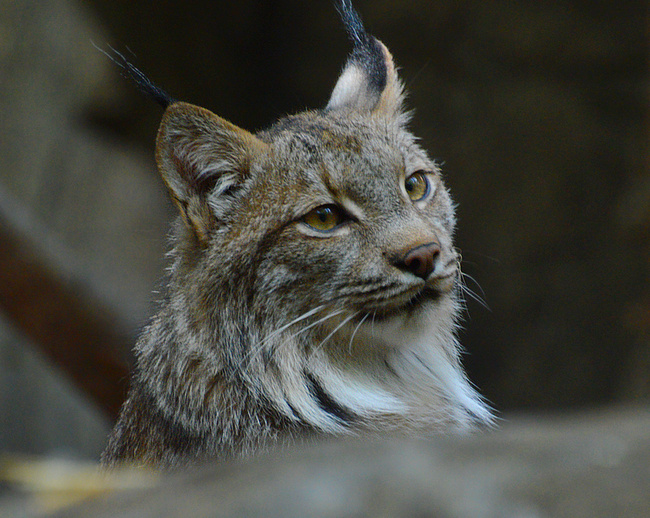
Two birds were flitting around in the trees at the top of the enclosure, a cardinal and, I think, a Black-and-White Warbler. (Were they able to fly into there from the main Laurentian Forest exhibit, or were they put in the enclosure specifically for enrichment? I don't know.) The lynx was very interested in them. It seemed very like an overgrown housecat as it stared up at them speculatively. It finally made a spectacular leap onto a tree trunk and then onto the rocks above. I think it's great that the lynx had something around to hunt, although the birds may not agree!

Montreal Biodome 2016 (part 2)
July 4th, 2016
The St. Lawrence marine ecosystem is always my favorite at the Biodome. It is not the only exhibit that puts no barrier between people and creatures, but of them all, it feels the most like being in the wild. Natural light streams in from above, kittiwakes and terns fly back and forth over your head. (People seem to worry about getting pooped on, but I've never seen it happen to anyone.) The ducks there are the kinds of ducks bird-watchers delight in--Harlequins, Eiders, Long-Taileds--and far closer in than we normally get to see them. I feel that I could just sit and soak in the ambience for hours, but my companions always insist on moving on eventually!
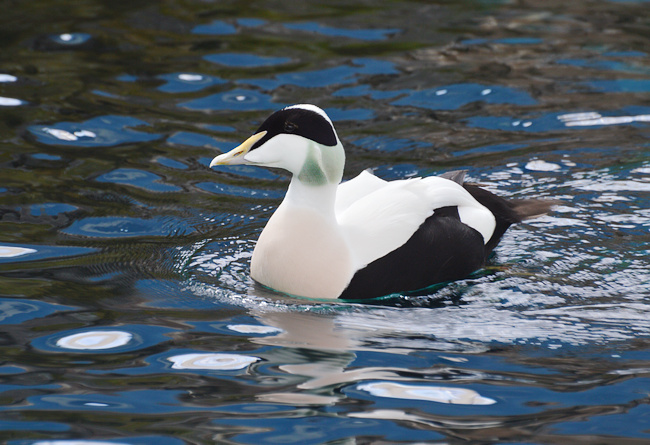
Male Common Eider. These handsome fellows are a common sight on the north Atlantic coast. (I lifelisted them in Gaspé, and saw more in Cape Breton last year.) They are also the source of eiderdown, the most expensive and effective down in the world. Since female eiders shed their own down to line their nests with, it can be harvested humanely by simply visiting the nests and gathering the down after the nesting season is over. This is still done today in Iceland.
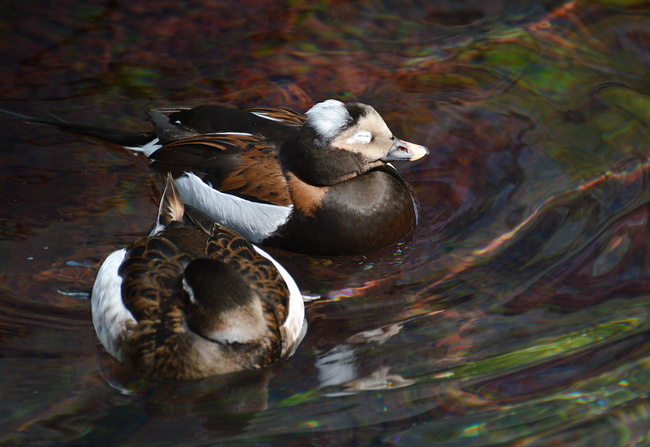
Long-Tailed Ducks having a nap. This species migrates through Ottawa, but I seldom see them, especially in their handsome breeding plumage.
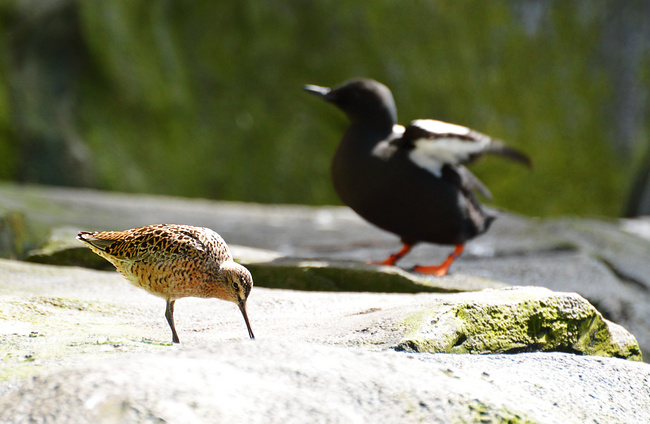
Amidst the obvious and charismatic birds of the Biodome, there are a number of others that are easily missed. I seem to see something new every time I go there. This was the first time I spotted a Dowitcher (in the foreground above), a type of sandpiper that, like many sandpipers, breeds in the Canadian far north. I didn't recognize it at first until I saw it probing the rocks with a "sewing machine" kind of motion. This is a giveaway for dowitchers mentioned in just about every field guide.
In the backdrop, a Black Guillemot with his trademark bright red feet.
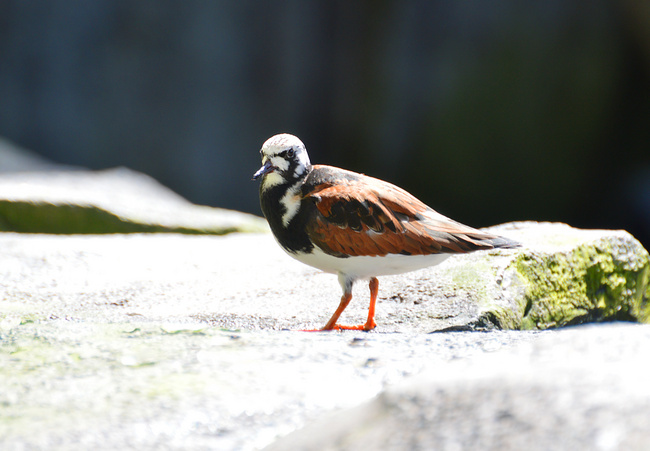
Ruddy Turnstone, an unusually colorful sandpiper. This species occurs wild in Ottawa (in migration), but has eluded me for nine years and counting. A captive bird, of course, cannot go on the lifelist!

Black-Legged Kittiwakes. Kittiwakes look similar to our familiar parking-lot-scavenging Ring-Billed Gulls, but are entirely different in their habits. They are strictly coastal, spend little time around humans, and nest in tiny crevices on sheer cliffs. Baby Kittiwakes have what one website calls "a very strong stay-put instinct." It's a long way down!
Continued in next post...
Montreal Biodome 2016 (part 1)
June 28th, 2016
On June 16th I went to the Montreal Biodome along with my mother (visiting from Virginia), my husband and his mother. I brought the camera and captured all that I could! This first set is from the tropical, South American exhibit.
You can see my previous photo shoot at the Biodome here, here, here, and here (four pages worth.) I tried to focus on different subjects this time, although I couldn't resist a second crack at the Hyacinth Macaws.
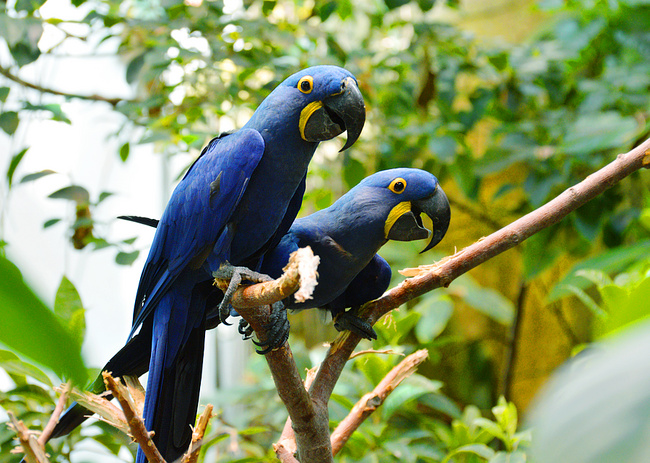
1680x1050 wallpaper
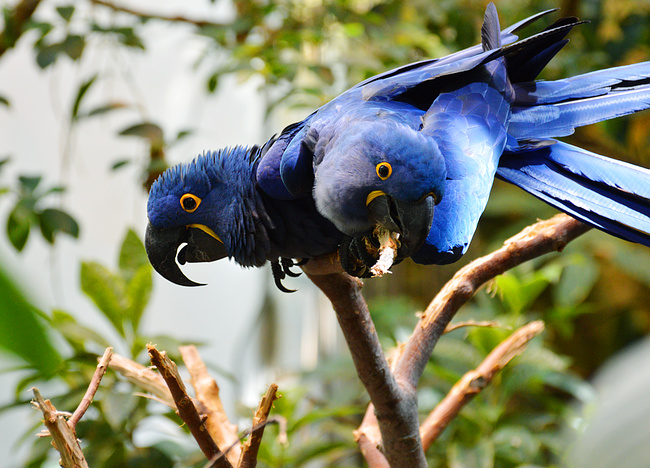
1680x1050 wallpaper
Sometimes it's hard to shake the impression that these birds are funning with me.

1680x1050 wallpaper
Golden Lion Tamarin--a highly endangered monkey, with only about 3200 left in the wild. We mammals are not usually known for our striking colors, but I think these tamarins rivalled for beauty the macaws and other tropical birds that surrounded them.
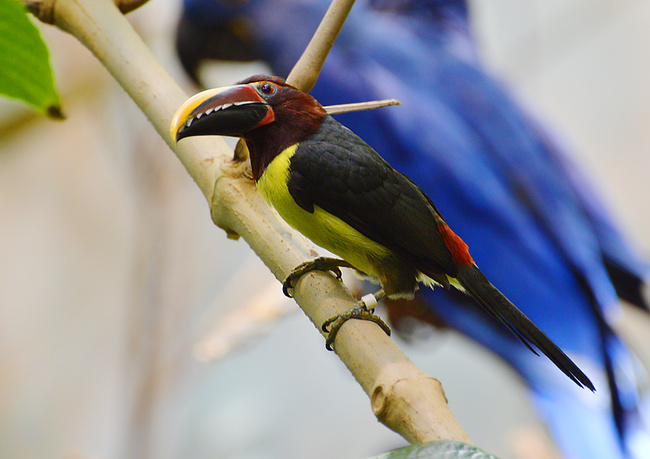
1680x1050 wallpaper
Green Aracari, a type of small toucan. (It is a close relative of the Fiery-Billed Aracari that Michael and I saw in the wild in Costa Rica.) That's a Hyacinth Macaw in the background, to give you an idea of scale.
( More (Scarlet Ibis, White Ibis) )
Breeding Birds In Frontenac Park
June 25th, 2016
I have figured out the cure for insomnia: go on a birding tour with Jon Ruddy.
No, I don't mean that Jon Ruddy's birding tours are boring, quite the opposite. I mean they are a workout and a half! At least this one was. Along with five other birders, we went to Frontenac Provincial Park, a 52 square kilometer protected wilderness north of Kingston, and birded the trails around Big Salmon Lake. It was May 23rd, but few spring migrants were present. Instead the woods teemed with local breeders, singing and nest-building and occasionally fighting with their neighbors.
Many birders' approach to hearing an interesting bird in the distance is to stand on the trail, pish, maybe play recordings of that bird's song, and hope that it will get curious and come within view. Jon's approach is more like this (paraphrasing):
"I hear a Scarlet Tanager over there! Lets go!" bushwhack bushwhack bushwhack CLIMB CLIMB CLIMB descend descend descend
"I hear a Cerulean Warbler back over there!" Lets go!" bushwhack bushwhack bushwhack ...
It helped that the woods were quite open, but there was much scrambling up and down rocky outcroppings. I liked this approach for a few reasons: it made for a terrific workout, it made for a much more interesting hike (I'm often a little bored by the "stand and wait" approach to bird-watching, and it's seldom how I do things when I bird alone), and it meant not confusing/upsetting birds with playback. That's something I've never been entirely comfortable with. I've always wondered: what if a male feels so threatened by this imaginary rival that he just up and leaves a perfectly good territory? Or what if a female wastes valuable time and energy trying to find the imaginary mate, lingering because of that tantalizing song, when she could move on and find a real mate elsewhere? I still remember the reaction I got from a brief playback on a Sora. It called incessantly ("ker-wee?") for the twenty minutes I sat there. When I came back through later, it was still in the same place, still calling incessantly. I felt bad for it.
No photos. For this trip, I just wanted to drink in the sights and sounds, instead of needing to capture them. (I will likely do this trip again next year, and possibly bring the camera then. I also plan to go back to Frontenac on my own sometime.)
Frontenac is stunningly beautiful--and underappreciated, judging by how many people we met on the trail on a holiday weekend. In some ways the park, at least the bit of it I saw, is very reminiscent of South March Conservation Forest. The rocky sunlit outcroppings, for instance, colored with generous sprays of Wild Columbine, with Rose-Breasted Grosbeaks singing on the margins. Climbing up onto those outcroppings I felt like I was back home again.
Down in the woods, I turned up a Dutchman's Breeches. Like the ones I saw in South March on the 15th, it had already lost its blossoms. Even the leaves were gone (wilted and vanished into the leaf litter, I guess), but I recognized the thin, pale green seed pods, arranged in a row along the drooping stem. As I handled the stem, some of them fell off. (Soon the pods will burst, revealing seeds with fleshy appendages called elaiosomes. Ants will carry the seeds back to their colonies, feed the elaiosomes to their larvae, and leave the seeds in a good place to germinate: a symbiotic relationship.)
In other ways it's not reminiscent of South March at all, as in the Cerulean Warblers that were singing all over the place. This little aqua-blue warbler is an endangered species in Canada, and Ottawa has maybe one or two known breeding pairs. Frontenac Park is their heartland. In general, Frontenac had a ruggedness and majesty about it that was unlike anything I'd experienced in Ottawa or Gatineau--one that rather reminded me of Algonquin Park (but much less boreal.)
Highlights:
A knee-buckling view of a blazing Scarlet Tanager, about fifteen feet away at eye level, completely out in the open, singing. I honestly didn't believe it was possible for a Scarlet Tanager to act like that. I thought "hide in the foliage fifty feet up taunting the bird-watchers" was pretty much their genetic programming. We never did a single playback and yet this thing happened.
Same spot: Cerulean Warblers whizzing back and forth practically in front of our faces. These are canopy birds, but the boulder we had climbed to get to the tanager more or less put us in the canopy!
Female Black-Throated Green Warbler and Rose-Breasted Grosbeak landing down on the rocks and foraging for nest material.
Close up views of a Yellow-Throated Vireo, a bird I'd only ever seen before at a great distance.
A Barred Owl, wide awake in the middle of the day, in plain view and calling back and forth with its distant mate.
"Whoooo whoooo?"
"Who cooks for you, who cooks for youuuu!"
(I can only gather that sightings like this are commonplace in Frontenac. A couple of backpackers came by and I asked them if they'd like to see an owl. An invitation like that in Ottawa or Gatineau would usually garner interest, even from people who aren't bird-watchers per se. They just waved their hands and moved on, saying that they'd seen all kinds of owls already.)
In the afternoon, after I had bolted down a heap of extra hot capicollo and SunChips within the allotted fifteen minutes, we went to Napanee Limestone Plain IBA (important bird area). This is a mosaic of grazed pastures, savannah-like grasslands and scrubby woodlots, all growing on a thin layer of soil over limestone bedrock--i.e., an alvar. Alvars are an increasingly rare habitat, supporting many declining, grassland-loving species. Napanee IBA is crucial breeding habitat for the endangered-in-Canada Loggerhead Shrike, one of North America's very few carnivorous songbirds, which would be a lifer for me.
Unfortunately my prospective lifer failed to show. (I'll be back!) So I contented myself to enjoy the Eastern Meadowlarks, Bobolinks and Upland Sandpipers, all of which we saw more of than you could shake a stick at.
And then I went home and slept like the dead.
The Showstopper
June 7th, 2016
On May 18th, I headed out to Mud Lake before sunrise, and rediscovered how incredible the trail can be when you're the first person to hit it! Early morning surprises included: A Great Egret fishing next to a muskrat lodge where a Canada Goose was sitting on eggs (surprisingly, the goose didn't seem to mind.) A raccoon about ten feet up a tree trunk, grabbing at the stump of a branch so he could lean out to peer curiously at me. The resident Eastern Screech-Owl in his hole with his eyes still wide open.
In the pine woods, a group of recently fledged teenage ravens was hopping from tree to tree and making an unholy racket as only teenage ravens can do. Then I was surprised to hear a strange sound that actually rivalled theirs for volume: a sort of rich cackling that resounded through the forest. At first I thought it was one of them playing with his voice, and even once I realized I was hearing a Wild Turkey gobbling, I thought it might actually be one of the ravens imitating a turkey. (I've caught a raven imitating a goose before, so it didn't seem too much of a stretch!)
But then I spotted him, a wild tom turkey, up in a tree by the water. After a good look and listen I walked on. When I came back through later, the sun was up, my camera was out, and he was on the trail putting on a show.
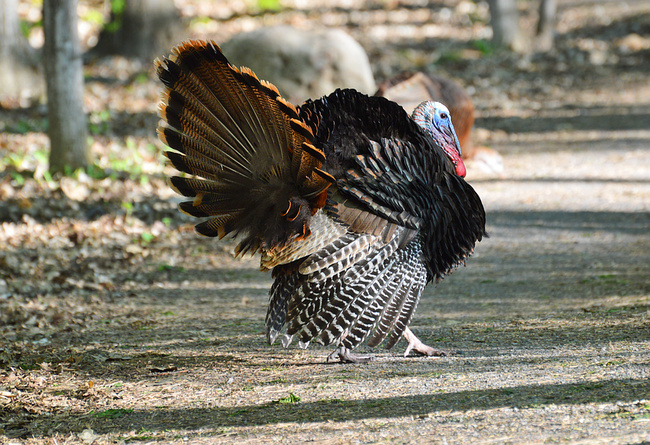
He was fearless. He strutted up and down the path, fanning his tail and ruffling his feathers. He made clear that he considered the trail his display court, and that while he didn't particularly object to me watching, if I happened to be standing in his way...well, one of us was going to have to either back up or go around, and it wasn't going to be him.
He actually seemed to gauge his tail-fans so that the morning sun caught them perfectly. Tail closed, he stepped into a shaft of sunlight, and suddenly...
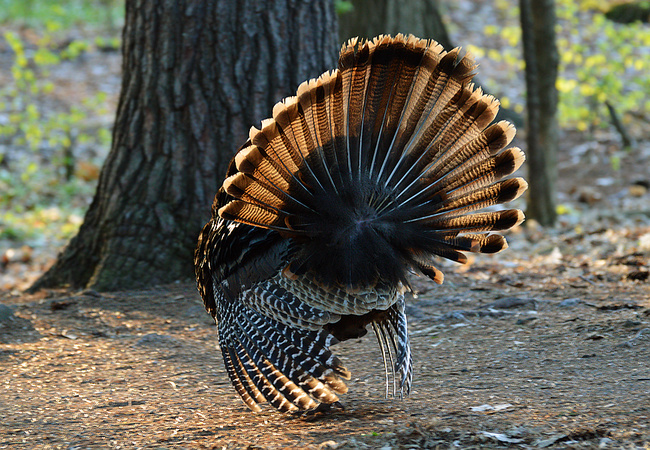
1680x1050 wallpaper
Pictured below with the female in front. This is not the first time a Wild Turkey has shown up at Mud Lake, but it is, as far as I know, the first time one has found a mate there.
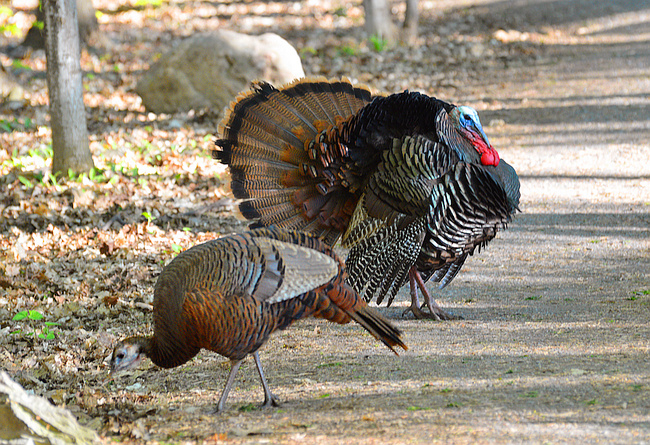
In other news, newborn goslings. It was a frigid morning; good thing they had their parents to keep them warm.
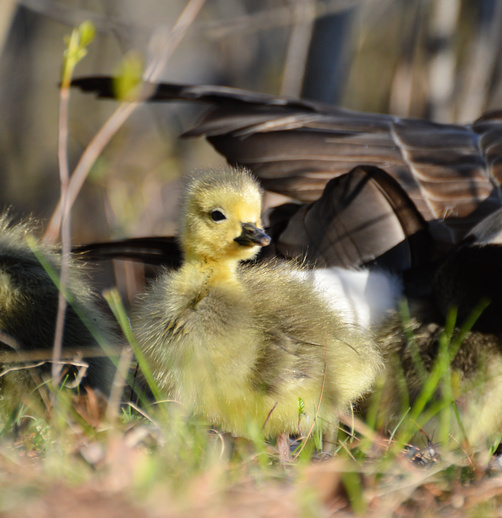
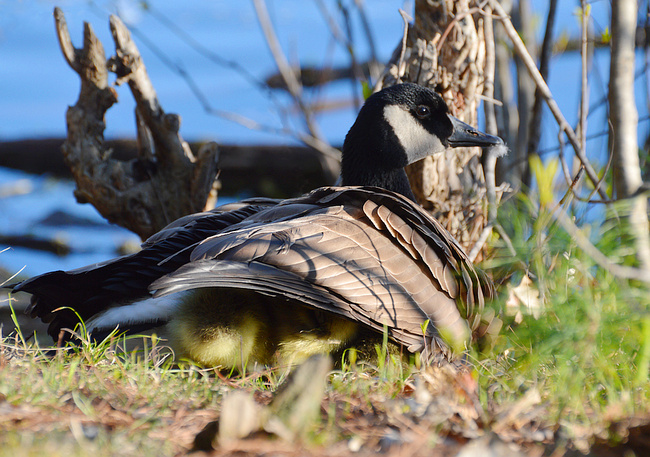
Courting terns and vanishing wildflowers
June 2nd, 2016
On the 15th of May I went back to South March Conservation Forest with Michael. I remembered vividly where that sunny slope was that I found the Dutchman's Breeches.
(Why? Well, because it was just past a long, very narrow bridge across a wet area--the kind of bridges South March is full of, and I always look at them and wonder how the mountain bikers manage it--and as I was photographing the flowers a guy came riding down that bridge and went off it and crashed. He afterwards admitted that he had gone off it because he was watching me take photos instead of watching where he was going! He was thankfully unhurt, but the whole thing certainly impressed upon me a vivid memory of that spot.)
Anyway, I refound the slope, and was stunned to see the Dutchman's Breeches entirely gone, with scads of White Trillium in their place. They had been in full bloom nine days ago. I was able to find the plants thanks to their distinctive leaves, but all of the blossoms were replaced by pale green seed pods, with nary even a wilted petal in sight. I've never seen flowers disappear so fast!
Water bodies come and go at South March according to the whims of beavers. In roughly the middle of the conservation area is a huge beaver pond called Heron Pond. A few years ago, it dried up to a meadow, after the family of beavers apparently moved away. Now it's full and beautiful again, and West Pond is the one that's drying up.
At one outlook on Heron Pond, Michael and I stood for quite some time to enjoy the antics of three Common Terns. A female (presumably) rested on a log in the water, while a male diligently fished and brought her catch after catch. This is a courtship ritual for terns and often immediately followed by mating. A third male (again, presumably) came by and the two males got into spectacular aerial fights.
I'm curious to find out if Common Terns actually nest in the conservation area (or if they're just warming up for their arrival somewhere else.) I have so far informally tallied 54 breeding residents of South March, but I'm sure the list isn't complete yet.
Trillium, black flies and a loon
May 29th, 2016
(Okay, I didn't photograph the black flies.)
I went to Wolf Trail on the afternoon of the 11th to celebrate the recent opening of the Gatineau Parkway. In the past I've avoided the Eardley Escarpment in May and June, for fear of black flies. They were definitely out, but they weren't that bad. I suspect they had only recently emerged, since I mainly ran into them near running water, and they weren't biting much.
The next thing I discovered about Wolf Trail in May is that it is the motherload of Red Trillium. My goodness, Red Trillium everywhere! From big backlit beauties...
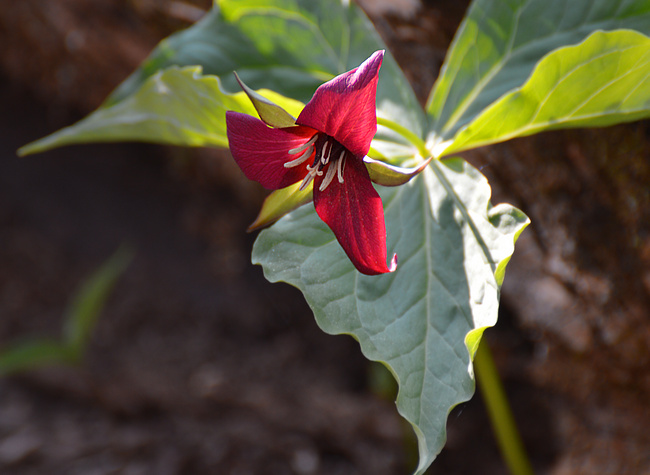
1680x1050 wallpaper
to little ones stooping in the shade.

It was an embarrassment of riches. At first I could scarcely focus on anything else, for all these gorgeous burgundy flowers everywhere I looked.
White Trillium was in bloom too.
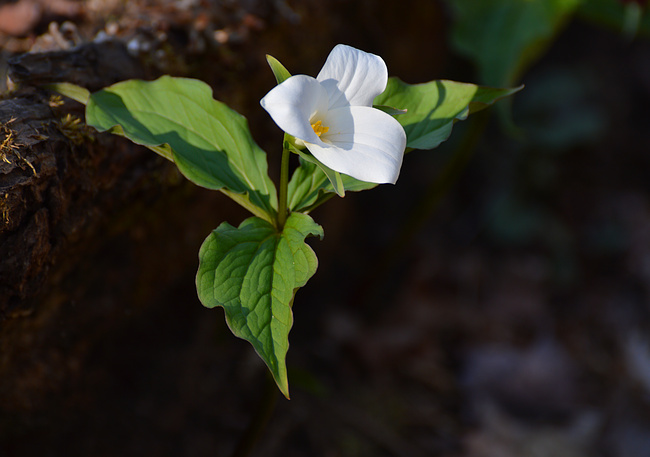
1920x1080 wallpaper
And various mystery plants were shooting up.
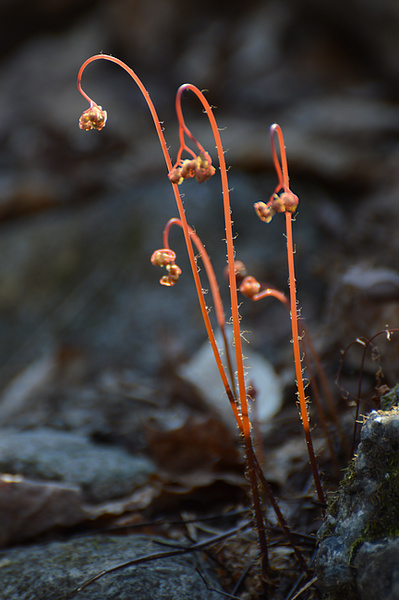
(Save for a bit of digital sharpening, that is an unaltered photo.)
When I got back to Meech Lake, I was pleasantly startled to see a loon swimming quite close to shore. (Another advantage of going to this area in May: once Blanchet Beach is open to swimmers, there aren't going to be any loons there!) I managed one photo before it noticed me, ducked under and (as loons do) resurfaced much, much further out in the lake.
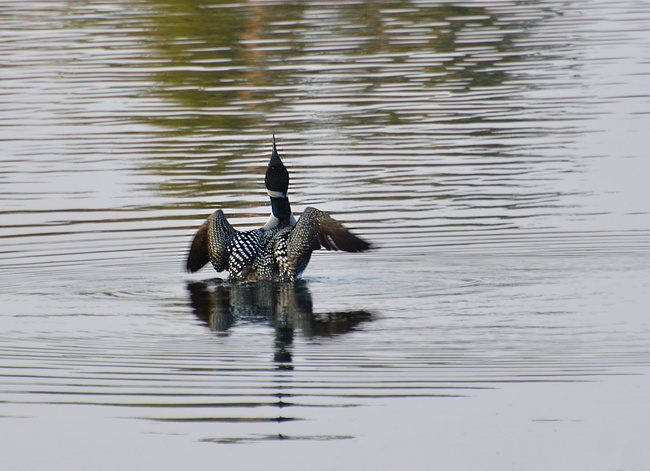
( More (White-Crowned Sparrow, Bellwort) )
Impressions of Mud Lake (part 2)
May 24th, 2016

1680x1050 wallpaper
Common Grackle. "Yes, as a matter of fact, I do own this swamp."
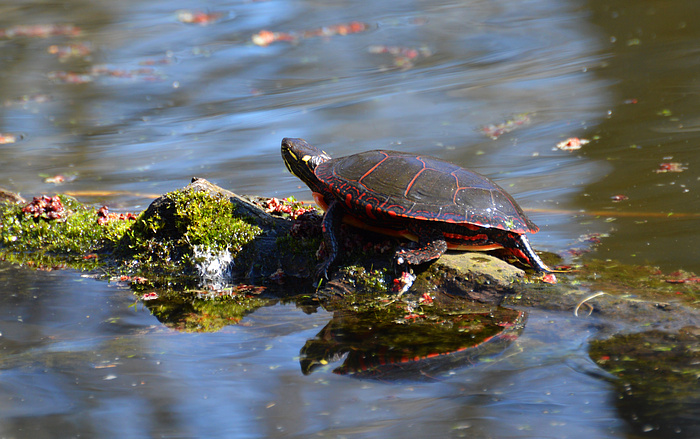
1680x1050 wallpaper
I think it's just another Painted Turtle, but I found the coloration on this one particularly striking.
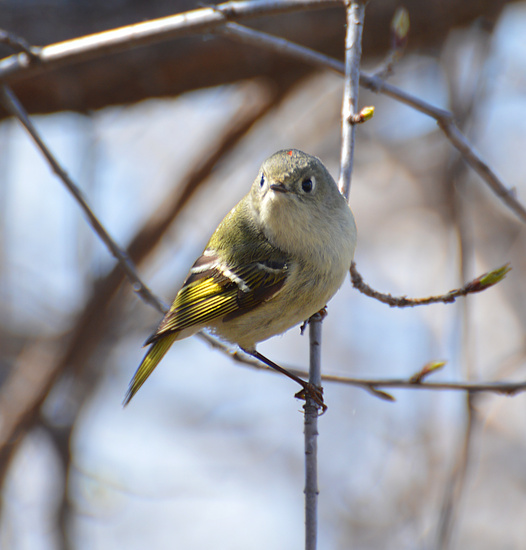
A surprisingly colorful Ruby-Crowned Kinglet, and the only migrant (i.e. non-resident of Mud Lake) in this set. I'd never seen one with as bright a shade of yellow on the wings. As usual, I only manage to capture the barest trace of the ruby crown. A Ruby-Crowned Kinglet has to erect its crown feathers to show off the red patch, something it seldom does for more than a moment at a time.

White-Breasted Nuthatch
The most interesting sighting of the day proved unphotographable (it went by too fast and too distantly, and I was standing on an unsteady beaver dam at the time!) Six or seven grackles were perched low on some fallen vegetation, looking down at the shallow water and making scolding notes that sounded almost like hissing. The object of their derision seemed to be a muskrat. As it swam along, they followed above, scolding all the way. I wondered why these grackles were so incensed by a harmless muskrat.
But when it emerged onto land, what I saw was much too lithe and sinuous to be a muskrat. It was a mink! Maybe hoping for a tasty breakfast of grackle chicks? By the time I finished fording the beaver dam, it was gone.
Impressions of Mud Lake (part 1)
May 21st, 2016
My trip to Mud Lake was meant for the photographing of spring migrants, but it was all the locals, instead, who wanted their pictures taken!

1680x1050 wallpaper
A female Red-Winged Blackbird, often mistaken for some sort of sparrow. (I blush to admit that when I saw my first back in 2007, as a novice birder, I mistook her for a waterthrush!) Look closely and you can see that she has a bit of her eponymous feature, though it's more rusty than properly red.
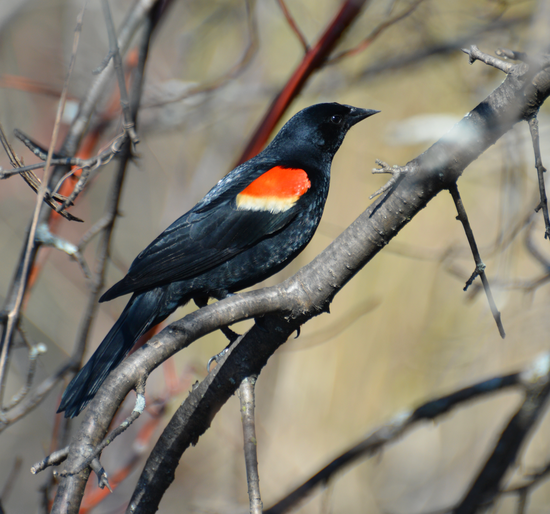
1680x1050 wallpaper
A male looks on nearby--perhaps her mate? Actually, a successful male redwing (one who has managed to secure a prime bit of habitat) can have over a dozen females nesting in his territory and raising his young.
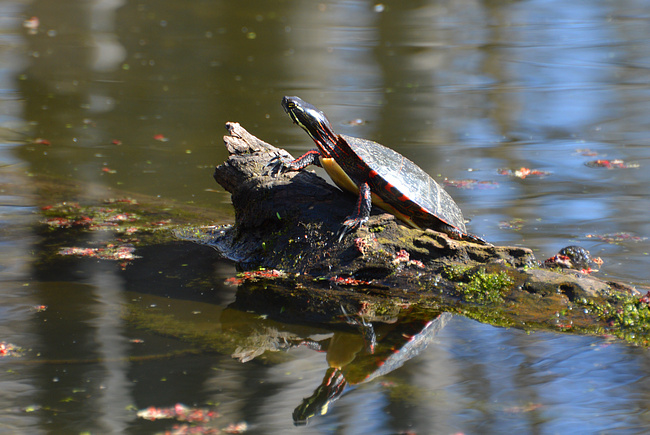
Painted Turtle, common in many ponds and marshes throughout Ottawa.
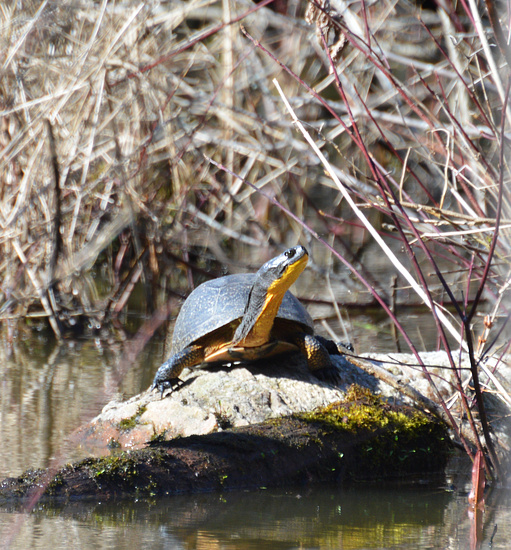
1680x1050 wallpaper
A Blanding's Turtle surveys his domain. This is a much rarer species than Painted Turtle, and in decline. (To tell them apart, note Blanding's solid yellow throat and much more convex shell. It's also larger on average.) I have seen them only in three protected areas: South March Conservation Forest, Carp Ridge, and Mud Lake. Any Blanding's Turtle sighting makes my day, as it reassures me that they still have a toehold in Ottawa's wildest wetlands.
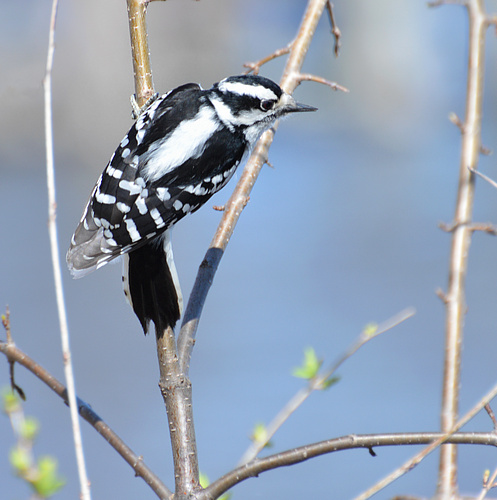
This little Downy Woodpecker had just noticed a woman holding out birdseed. A moment after I took the photo it was in her hand!
Spring Outing
May 16th, 2016
Another close encounter at South March Conservation Forest.
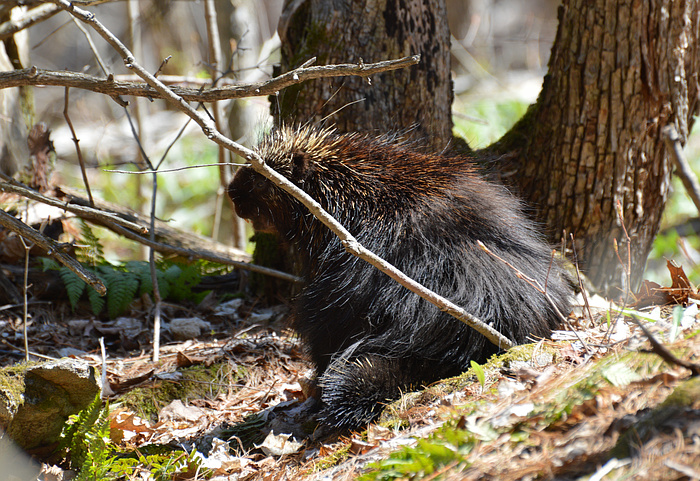
1680x1050 wallpaper
Porcupines are usually nocturnal animals that sleep in trees by day, but in early spring, they can sometimes be seen out and about, noshing on fresh buds and other vegetation. They're nearsighted, and though they supposedly have a great sense of smell, they seldom seem to notice me before I notice them. Of course, since almost no one wants to tangle with a porcupine, they can afford to be oblivious!
This one practically walked into me. By the time I took this photo, though, he knew I was there, and you can tell by the quills that he was a little tense. I left him alone after that.
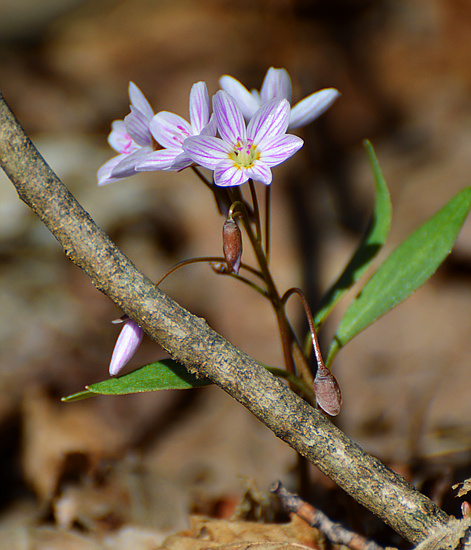
Spring Beauty (by name and by nature.)
|
